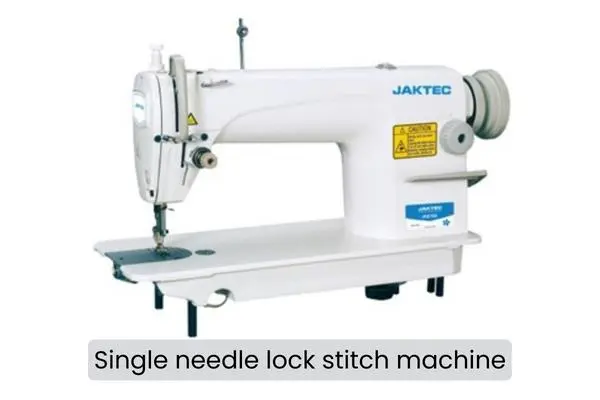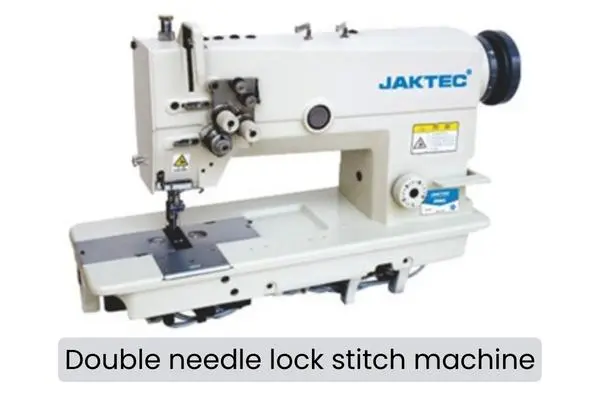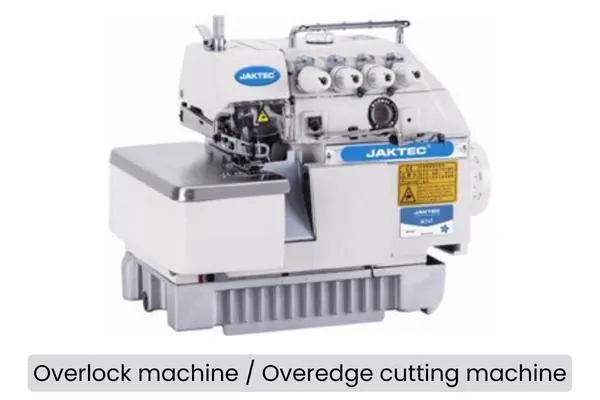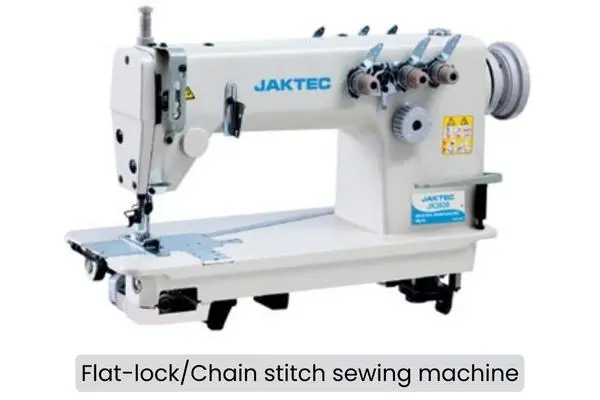Types Of Sewing Machines Used For Apparel Products Like Shirts, T-Shirts, Trousers, And Jeans – By Tushar Soliwal
Department of Textiles (Fashion Technology) DKTE’S Textile and Engineering Institute, Ichalkaranji, India
Email: tusharsoliwal01@gmail.com
There are several sewing machines and other equipment used in apparel industries, which are used to manufacture various varieties of apparel goods.
In this article, we will understand the various sewing machines used to manufacture products like shirts, t-shirts, trousers, and jeans. We also go through the operation breakdowns of these products to know about the process of product development.

Industries use sewing machines and equipment depending on the type of products, types of product applications, style, and design of products asked by the buyer. So, when it comes to consideration of the machine section at the time of production of goods, the highest numbers of machines are used in the sewing department [1]. The sewing department is the main production department in the apparel industry. There were more or less sets of different machines used at the time of pre-production and post-production activities.
Sewing machine types and technical adjustments
1. Single needle lock stitch machine (SNLS)
SNLS is a type of lockstitch machine, which is the most widely used type of sewing machine in the appeal industries. It is the most popular sewing machine that provides a wide range of sewing applications. This type of sewing machine is designed to stitch the raw materials with consistent results in the production room [2].
It provides precise and highly secured stitches in straight lines. The stitch present in the fabric layers is visible on the top side and at the bottom side of the fabric. The sewing needle penetrates throughout the material (fabrics) and stitches the material by the interlocking of needle thread and the bobbin thread.

This machine creates a strong, straight stitch using one needle and one thread which further creates basic garment construction. As we have seen earlier SNLS is the most widely used industrial machine.
This machine is adopted to stitch and produce almost all categories of appeal goods. It is used to stitch all varieties of fabrics like knits, woven, non-woven, leather fabrics, and many more. The single-needle lockstitch machine is specifically designed and commonly used for decorative stitching and adding visual appeal to garments. Following are major technical adjustments that are possible on the SNLS machine.
Technical adjustments possible on the SNLS machine
- Stitch length
- Thread tension
- Needle position Installation of needle
- Hook Set Timing
- Feed Dog Eccentric Cam Adjustment
- Feed Dog adjustment and alignment
- Pressure foot adjustment
- Needle bar Height adjustment
2. Double needle lock stitch machine (DNLS)
The DNLS machine is a machine that provides a wide range of stitching applications. It provides the same application as similar to the SNLS machine, but it also provides a high lockstitch mechanism that creates a tight and secure stitch as compared to SNLS.
There are two needles means two needle threads and two bobbin threads present which provides high strength to stitch. The straight stitches follow a straight line as per the product application. Both stitches are exactly parallel to each other.

Figure 2 shows the DNLS machine and the technical adjustments of the DNLS machine as listed below. DNLS machine is applicable for some categories of products like, leather goods, woven, home textiles manufacturing, geotextiles, and others.
In apparel industries, DNLS is typically used for stitching hems, flat seams, and decorative elements on garments like shirts, T-shirts, jeans, and trousers. It also depends upon the buyer’s requirements and the style of the products. So, The double-needle lockstitch machine is specifically designed to create parallel rows of stitches using two needles and two threads. It is commonly used for decorative stitching and adding visual appeal to final products.
Technical adjustments of the DNLS machine
- Basic Machine Practice (Loop Exercise)
- Installation of needle
- Hook Set Timing
- Needle bar Height adjustment
- Sprocket belt adjustment and change
- Feed Dog alignment
- Feed Dog adjustment and
- Feed timing Cam adjustment
- Thread adjustment
3. Overlock machine / Overedge cutting machine
It is a high-speed industrial sewing machine that provides a wide range of sewing applications in apparel industries. It performs the sewing tasks at the quickest performing speed with over-edge stitches. This type of sewing machine is available in the market in the following specific types, they are classified as per the number of threads available in the sewing machine.
- Two thread overlock machine
- Three thread overlock machine
- Four thread overlock machine
- Five thread overlock machine
- Six thread overlock machine
An overlock edge cutting machine is used to stitch the edges of the fabrics and to cut the excess edge of the fabric if required. The cutter presents on the backside of needles cut the uneven edges and make them regular and even.

Following figure 3 shows a picture of an industrial overlock machine. This type of machine is applicable for knitted, woven, and non-woven fabrics. Widely used in apparel industries to stitch the garments like shirts, t-shirts, jeans, and trousers, and for suiting applications, undergarments manufacturing, and others.
They are designed to sew, trim, and finish fabric edges simultaneously, preventing fraying and providing stretchability to the seams. So, due to its wide range of applications in sewing sectors almost all clothing industries use overlock stitching machines and their types.
Technical adjustments of the OVERLOCK machine
- Basic Machine Practice
- Installation of needle
- Thread Adjustment
- Upper Knife Adjustment
- Lower Knife adjustment
- Needle bar Height adjustment
- Needle to lower looper timing
- Upper Looper Timing
- Chain looper timing (Safety Stitch)
- Feed Dog Height adjustment
4. Flat-lock/Chain stitch sewing machine
A flat-lock stitch machine is also known as a chain stitch machine. Is a special type of high-speed sewing machine. Their types of sewing machines are majorly two types namely single-needle flat lock machines and multi-needle flat lock machines. These types of sewing machines have two or more needles that penetrate through fabric layers. The needle thread and lopper thread interlock each other and form loops over the fabric layer.

These types of machines are widely applicable to sewing knitted goods to form the comfortable seams desired. The flatlock stitching machine is widely used in the production of activewear, sportswear, and almost all types of T-shirts. It is specifically designed to create flat and flexible seams that are comfortable against the skin.
The flatlock stitch allows the seam to lie flat, reducing bulk and increasing the overall comfort of the garment. Let us discuss the technical adjustments of the Flatlock machine. The following figure 4 shows the image of a flatlock stitching machine.
Technical adjustments of the Flatlock machine
- Basic Machine Practice
- Installation of needle
- Feed Dog Height adjustment
- Cam Timing (Thread)
- Needle and looper guard adjustment
- Needle bar Height adjustment
- Main looper timing
- Spreader Looper Adjustment
- Stitch Length Adjustment
5. Button hole machine
Buttonhole machines are used to create perfectly sized and positioned buttonholes in shirts, T-shirts, jeans, trousers, and other garments that require buttons. They automate the process and can produce consistent and durable buttonholes. This type of machine provides high efficacy consistency and accuracy in sewing operations. As per the demand of the customers manufacturers use button-hole machines.

After the creation of the hole for the button in the product, a button-attaching machine is used to attach the button to the garment. After completion of these operations, it creates a better astatic look into the final product and makes the product more durable. It has a special mechanism that cuts and sews the buttonhole in one step.
Technical adjustments for this machine include the following points. Following figure 5 shows the image of a button-hole machine used in apparel industries.
Technical adjustments of the Button Hole Machine
- Basic Machine Practice
- Technical Specification
- Hook Set Timing clearance
- Thread trimming or scissors timing adjustment
- Knife Adjustment and change
6. Button attach machine
This is a high-speed button-attaching machine, which is used after the sewing buttonholes operation. After completion of the buttonhole operation, this was carried out. To attach the button to the garments like shirts T-shirts, jeans, and casual trousers that machine is widely used.

The following shows 6 shows the image of the Button attached machine used in apparel industries. Now let’s discuss some technical adjustments to the Button Attach machine.
Technical adjustments of the Button Attach machine
- Basic Machine Practice
- Technical Specification
- Work Clamp adjustment
- Installation of needle
- Needle Bar height adjustment
- Button center adjustment
- Thread trimming adjustment
7. Bartack machine
This machine is widely used for giving secure bartack stitches in garments where high stress is applied. Bartack is a high-speed specialized machine that creates a zigzag type of stitch on the garment at required places. The operator places the garment on the bartack machine under the needle and guides the garment.
Needles penetrate through the garment and form zigzag stitches in the garment area following the desired path, operator must control the speed of the machine and the stitch length. Let us go through the image (figure 7)

This machine is used for verities of products where high stress is present like waistbands, and crotch areas. Also, while manufacturing jeans for operations like back pocket attachment, zip attachment, waistband attachment, and coin pocket attachment bartack machine is essential to perform these operations. Technical adjustments which are to be taught while dealing with Bartack machines are given below.
Technical adjustments of Bartack machine
- Basic Machine Practice
- Installation of needle
- Needle Bar height adjustment
- Stitch length adjustment
- Thread trimming Adjustment
Here we discussed major types of sewing machines used in apparel industries and we also went through various technical adjustments of the same. Please go through the given link to better understand the advanced sewing machine used in garment factories.
Operation breakdown
Operation breakdown is a systematic process which mostly used by industrial engineers in the garment industry. So, the operation breakdown is a sheet that contains the name of the operation, the type of machine, and total machines required to perform that operation, the standard allowed minute, and the total time. This sheet helps for costing purposes. Now, we have to understand the operation breakdown of some common products like Shirts T-shirts, trousers, and jeans. As we understand the machine type and their adjustments and now let us deals with the operation breakdown of the above products and the type of machine used. This gives a clear idea about, how the product is manufactured and also, which machine is used to perform the required operation.
Operation Breakdown: Following tables show the OB of respective products
1) Polo T-Shirt
| Sr. No. | Name of the Operation | Type of Machine Used |
| 1 | Placket Mark | TABLE |
| 2 | Placket Role & Body Match | OVERLOCK |
| 3 | Attached Placket | SNLS |
| 4 | Placket Fold Tuck | SNLS |
| 5 | Front Back Machine | TABLE |
| 6 | Shoulder Join & Cut | TABLE |
| 7 | Care Label Attach | SNLS |
| 8 | Collar Making | TABLE |
| 9 | Collar Join | OVERLOCK |
| 10 | Sleeve Match | OVERLOCK |
| 11 | Sleeve Join with Body | SNLS |
| 12 | Sleeve Join | TABLE |
| 13 | Collar Binding | SNLS |
| 14 | Binding Cut & Over Turn | TABLE |
| 15 | Collar Top Stitch | SNLS |
| 16 | Placket Close (R) | SNLS |
| 17 | Placket Close (L) | SNLS |
| 18 | Make Placket Box | SNLS |
| 19 | Arm Hole Join | FLATLOCK |
| 20 | Side Seam | OVERLOCK |
| 21 | Button Hole | BOTTON HOLE M/C |
| 22 | Button Attach | BOTTON ATTACH M/C |
2) Polo Shirt
| Sr. No. | Name of the Operation | Type of Machine Used |
| 1 | Fuse Placket | FUSING M/C |
| 2 | Hem Front Placket | SNLS |
| 3 | Bottom Hem | FLATLOCK |
| 4 | Size Label to Main Label | SNLS |
| 5 | Main Label to Yoke | SNLS |
| 6 | Attach Placket to the Front | SNLS |
| 7 | Cut Placket | MANUAL |
| 8 | Front Placket Edge Stich | SNLS |
| 9 | Sew Box at Placket | SNLS |
| 10 | Yoke Attach to Back | DNLS |
| 11 | Shoulder Overlock | 5TO/L |
| 12 | Top Stitch Shoulder | SNLS |
| 13 | Attach Piping to Collar End | SNLS |
| 14 | Turn Placket Ends & Finish Piping | SNLS |
| 15 | Cuff Overlock | 5TO/L |
| 16 | Cuff Top Stich | SNLS |
| 17 | Sleeve Attach | 5TO/L |
| 18 | Sleeve Top Stich | SNLS |
| 19 | Slits Marking | SNLS |
| 20 | Side Seam Overlock & Bottom Overlock | 4T O/L |
| 21 | Tack At Sleeve End | SNLS |
| 22 | Button Hole | BUTTON HOLE |
| 23 | Button Attach | BUTTON ATTACH |
3) Jeans
| Sr. No. | Name of the Operation | Type of Machine Used |
| BACK | ||
| 1 | Pocket Hemming | HEMMING M/C |
| 2 | Pocket Overlock | 3T O/L |
| 3 | Pocket Creasing | TABLE |
| 4 | Pocket Attaching | SNLS |
| 5 | Pocket Tuck | SNLS |
| 6 | Second Stitch (Back Pocket) | SNLS |
| 7 | Back Yoke Attach | FEED OF ARM |
| 8 | Back Rise Join | FEED OF ARM |
| 9 | Size Label Attach | SNLS |
| FRONT | ||
| 10 | Coin Pocket Hemming | HEMMING M/C |
| 11 | Coin Pocket Attach | SNLS |
| 12 | Pocket Bag Attach | 5T O/L |
| 13 | Pocket Bag Overlocking | 3T O/L |
| 14 | Pocket Bag Top Stitch | SNLS |
| 15 | Zipper Fly Overlocking | 4T O/L |
| 16 | Front Panel Overlock | 3T O/L |
| 17 | Zipper Attach | DNLS |
| 18 | Left Fly Attach to Front Panel | SNLS |
| 19 | J Stitch | SNLS |
| 20 | Front Pocket Mouth Hemming | HEMMING M/C |
| 21 | Pocket Bag Stitch to Front Panel | SNLS |
| 22 | Right Flt Attach with Zipper & Crotch | SNLS |
| ASSEMBLY | ||
| 23 | Loop Preparation | 3T O/L |
| 24 | Label Attach | SNLS |
| 25 | Inseam Top Stitch | FEED OF ARM |
| 26 | Side Seam Join | 5T O/L |
| 27 | Side Seam Top Stitch | SNLS |
| 28 | Waist Band Stitch | WAIST BAND ATTCHING M/C |
| 29 | Waist Band Finish | SNLS |
| 30 | Loop Attach | LOOP ATTACHING M/C |
| 31 | Bottom Hemming | BOTTOM HEMMING M/C |
4) Trouser
| Sr. No. | Name of the Operation | Type of Machine Used |
| 1 | Front Rise Take with Stripe Match | SNLS |
| 2 | Front Rise Join | 5TO/L |
| 3 | Back Rise Join | 5TO/L |
| 4 | Front Rise Ts & Fly Shape stitching | SNLS |
| 5 | Care label Attach | SNLS |
| 6 | Front & Back Sticker Match | MULTI NEEDLE LOCKSTITCH |
| 7 | Side Seam Join (Long) | 5TO/L |
| 8 | Inseam Join (Long) | 5TO/L |
| 9 | Elastic Open & Live Stream | MULTI NEEDLE LOCKSTITCH |
| 10 | Elastic Measure & Cut | MULTI NEEDLE LOCKSTICH |
| 11 | Elastic Ring Make & Tk | SNLS |
| 12 | Elastic Mark for Attach | MULTI NEEDLE LOCKSTICH |
| 13 | Make Hole Position & Sew | BUTTON HOLE |
| 14 | Waist Belt Join | 4TO/L |
| 15 | Elastic Fold & Tk | SNLS |
| 16 | Waist Belt Ts | KANSAI |
| 17 | Drawstring Measuring & Cut | MULTI NEEDLE LOCKSTITCH |
| 18 | Insert Drawstring & Middling | MULTI NEEDLE LOCKSTICH |
| 19 | Drawstring BTK | BARTACK |
| 20 | Drawstring Mid BTK & Cross BTK | BARTACK |
| 21 | Bottom Hem | DNLS |
| 22 | Thread Trimming | MULTI NEEDLE LOCKSTICH |
Type of machines used and as per the product category
The following table 5 shows the major types of machines used for given products. As mentioned, the selection of the machine is depending upon the requirements of the buyer, the type of fabric used, the end application of the product, and the style of the product mentioned in the tech pack.
| Sr No. | Name of Sewing Machine | Product | |||
| T-Shirt | Shirt | Trouser | Jeans | ||
| 1 | Single needle Lock stitch machine | ✅ | ✅ | ✅ | ✅ |
| 2 | Single needle edge cutter machine | ✅ | ✅ | ✅ | |
| 3 | Double-needle Lock Stitch machine | ✅ | |||
| 4 | Overlock machines | ✅ | ✅ | ✅ | |
| 5 | Chain Stitch machine | ✅ | ✅ | ||
| 6 | Flat lock machine | ✅ | ✅ | ✅ | |
| 7 | Multi-needle chain stitch machine | ✅ | ✅ | ||
| 8 | Feed-of -Arm | ✅ | |||
| 9 | Zigzag sewing machine | ✅ | |||
| 10 | Button attaching machine | ✅ | ✅ | ✅ | |
| 11 | Button holing machine | ✅ | ✅ | ✅ | |
| 12 | Bartack machine | ✅ | ✅ | ||
Conclusion
In conclusion, we understand the importance of major sewing machines from the basic single-needle lockstitch machine to specialized machines like overlockers and buttonhole machines, each type of sewing machine serves a specific purpose.
The use of sewing machines while garment manufacturing servers effective stitching performance. as well as the highest quality standards. By choosing the right sewing machine for each task, manufacturers can achieve better productivity, efficiency, durability, and aesthetic appearance in their apparel products.
The choice of a sewing machine depends on several factors, including the type of fabric, the design of the garment, and, standards asked by the customer, the end application of the product, and the desired finish. Thus, sewing machines play a crucial role in the production of various apparel products. They help to stitch different types of garments efficiently and accurately.
References:
1. List of Machines and Equipment Used in Garment Manufacturing. (n.d.). Garment Export House. Retrieved June 16, 2023, from https://www.garmentexporthouse.com/2021/10/list-of-machines-and-equipment-used-in.html
2. Retrieved June 16, 2023, from https://www.google.com/url?sa=t&source=web&rct=j&url=https://textilescommittee.nic.in/sites/default/files/course-content/TC_GMT_11.pdf&ved=2ahUKEwjU25rL-8b_AhU0a2wGHUuRCJ0QFnoECA4QAQ&usg=AOvVaw1_TRf40qdt8X05lEF0-Yw2
3. Hosen, Md. (2020). Reduction of Garments Bottleneck Processing Time on the Sewing Line of the Garments Industries. International Journal of Textile and Fashion Technology. 5. 1-10. 10.33552/JTSFT.2020.05.000611.
4. Operation Bulletin of a Polo Shirt. (2016, December 22). Online Clothing Study. https://www.onlineclothingstudy.com/2016/12/operation-bulletin-of-polo-shirt.html
5. Operation Breakdown, SMV, and Machine Summary of Basic 5 Pocket Jeans. (n.d.). Retrieved June 16, 2023, from https://www.onlineapparelstudy.com/2022/02/operation-breakdown-smv-and-machine.html
6. Shaikat, N. M. (2018, October 5). Operation Breakdown and SMV of Trouser. ORDNUR. https://ordnur.com/apparel/operation-breakdown-and-smv-of-trouser/
